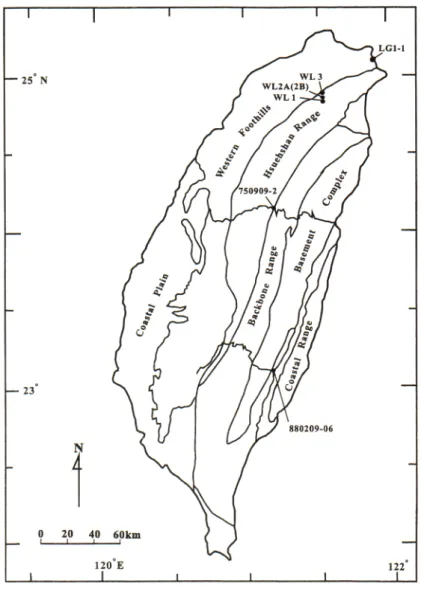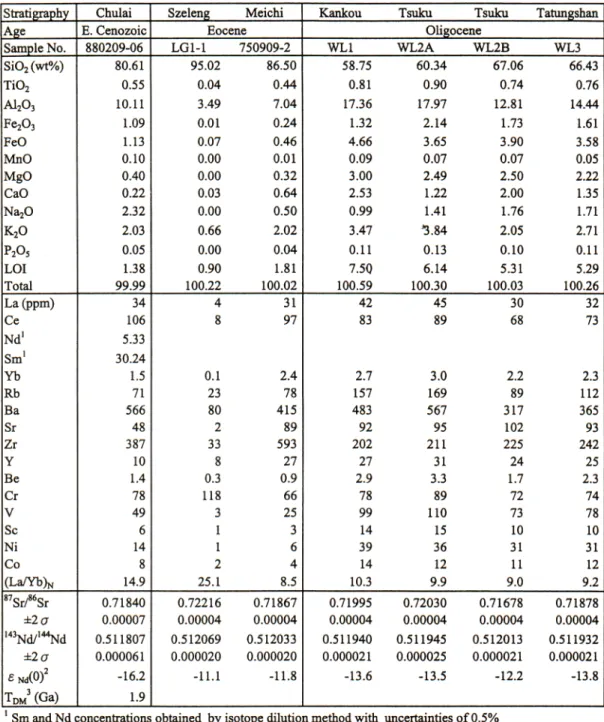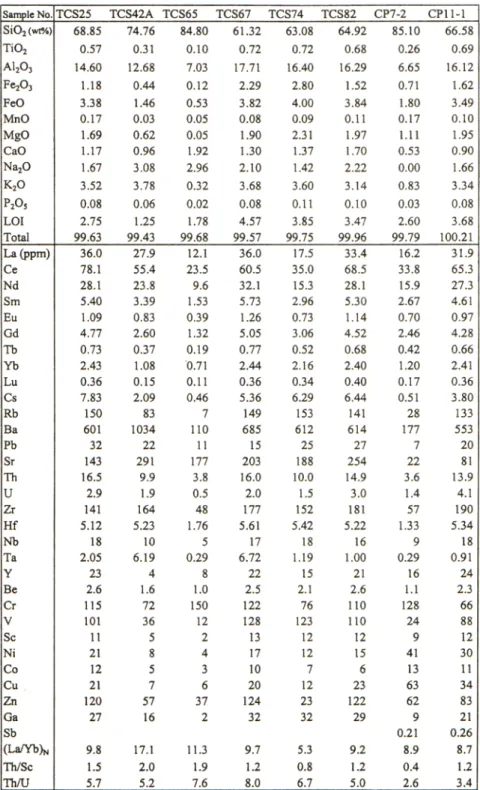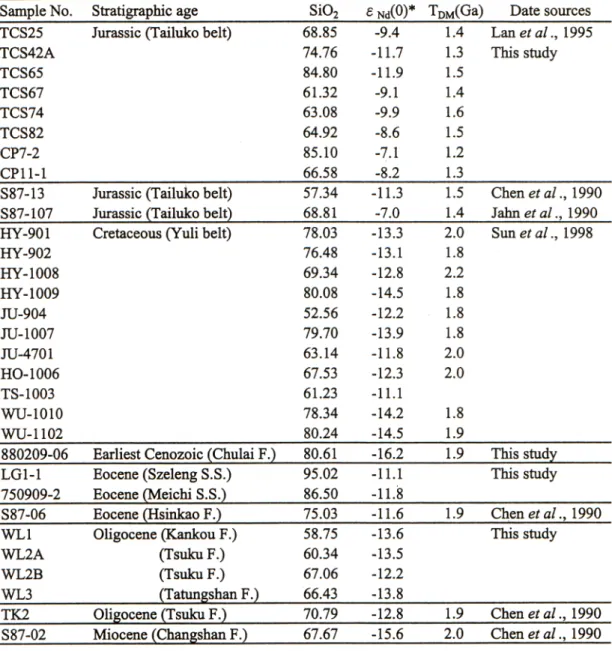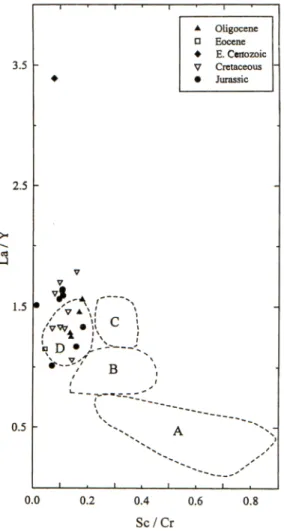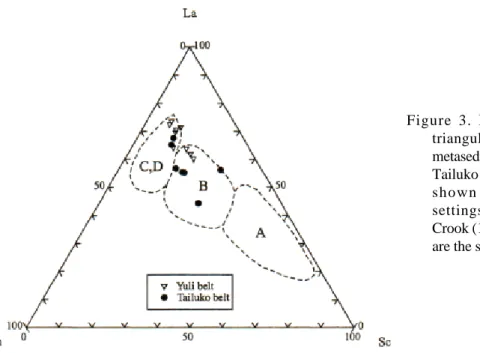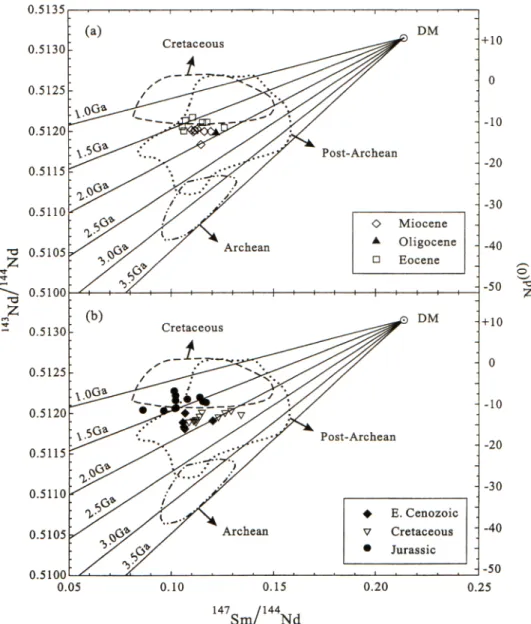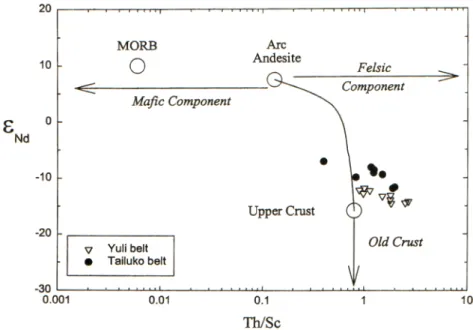205
WESTERN PACIFIC EARTH SCIENCES Vol.2, No.2, P.205-222, 5 Figs., 3 Tabs., May, 2002
Nd-Sr ISOTOPIC COMPOSITION AND GEOCHEMISTRY OF
SEDIMENTS FROM TAIWAN AND THEIR IMPLICATIONS
CHING-YING LAN1, CHUN-SUN LEE2, JASON JIUN-SAN SHEN1,CHIA-YU LU3, STANLEY A. MERTZMAN4 AND TSAI-WAY WU5
1. Institute of Earth Sciences, Academia Sinica, Nankang, Taipei, Taiwan 2. Department of Earth Sciences, National Taiwan Normal University, Taipei, Taiwan
3. Department of Geosciences, National Taiwan University, Taipei, Taiwan 4. Department of Geosciences, Franklin and Marshall College, Lancaster, U. S. A.
5. Department of Geology, The University of Western Ontario, London, Canada
ABSTRACT
The Nd isotopic composition and geochemistry of the earliest Cenozoic to Oligocene metasedimentary and sedimentary rocks together with those of metasedimentary rocks of the Tananao Schist in Taiwan were studied. Most rocks demonstrate geochemical and Nd isotopic characteristics typical to those of the upper continental crust in the South China region. These results imply that most rocks are recycled continental crustal material. However, Nd isotopic compositions seem to show secular variation of decreasing εεεεεNd value with deceasing stratigraphic age for both the pre-Eocene metasedimentary rocks and the Tertiary sedimentary rocks. The high εεεεεNd values for the Eocene rocks compared to other Tertiary rocks are probably due to the incorporation of sediments from Cretaceous I-type rocks of Southeast China. The Jurassic metapelites of the Tailuko belt exhibit the highest εεεεεNd values among all metasedimentary rocks. This suggests that either the source material of the metapelites of the Tailuko belt had received mantle inputs (arc material) or that the metapelites were later metasomatized during a granitization event which occurred in the Cretaceous Period.
Key words: Nd-Sr isotope, geochemistry, sediment, Taiwan, South China
INTRODUCTION
Sediments and granitoids provide an excellent opportunity to foster our understanding of the formation and evolution of continental crust through geological time. Chen et al. (1990)
206
Western Pacific Earth Sciences, Vol.2, No.2
conducted Sm-Nd isotopic and geochemical studies on late Paleozoic to Miocene sedimentary and metasedimentary rocks of Taiwan and found no obvious secular variation with respect to the deposition age of those rocks. They suggested the sources of the sediments were primarily recycled pre-existing continental crust and derived from typical continental crust. A few late Paleozoic metasedimentary rocks might have been influenced by fresh mantle inputs to their provenance. Lan et al. (1995) carried out a Sr-Nd-O isotopic study of mid-Cretaceous granitoids and associated metapelites of the basement complex (Tananao Schist) of Taiwan. They concluded that both granitoid and metapelites received not only recycled continental crustal material but also fresh mantle input. Based on published data, Lan et al. (1996) summarized that late Paleozoic to early Mesozoic metasedimentary rocks of the Tananao Schist (Old Taiwan) have higher εNd
values (-12 to -6) than those (-15 to -9) of sedimentary rocks ranging from the late Mesozoic to Miocene of Taiwan (Young Taiwan). Sun et al. (1998) examined the Sr-Nd isotopic and geochemical studies on Cretaceous meta-igneous rocks and blackschists of Yuli belt from the Tananao Schist of Taiwan. They indicated that TDM ages of blackschists are identical to Taiwan
sediments and are derivatives of the basement strata of the Eurasian continental margin. Extended metasedimentary and sedimentary rocks in Taiwan from the earliest Cenozoic to Oligocene age were studied. The geochemistry of the metapelites of the Tailuko belt, not discussed in Lan et al. (1995), is presented here. The main purpose of this paper is to document the new isotopic and geochemical characteristics of these metasedimentary and sedimentary rocks. Combined with previous data, the authors intend to describe the secular trends of Nd isotopic composition for these rocks. Such a feature was not observed in Lan et al. (1996). We will also provide one rationale for the occurrence of such a phenomena.
SAMPLES
The new samples collected in this study are one phyllite of Chulai Formation, one quartzitic sandstone of Szeleng Sandstone, one sandstone of Meichi Sandstone, one argillite of Kankou Formation, two sandstones of Tsuku Formation and one argillite of Tatungshan Formation. Their sample localities are shown in Figure 1.
The depositional age of several of the formation is problematic due to the lack of diagnostic fossils. However, the sequence of stratigraphic units is accurate according to the detailed field investigations of many geologists and is described by Ho (1988). The basement complex of Taiwan, the Tananao Schist, has experienced a complicated metamorphic and tectonic history. It has been divided into a western Tailuko belt and an eastern Yuli belt (Yen, 1963). The metapelite of the Tailuko belt belongs to the Tienhsiang Formation, which lies stratigraphically below the blackschist of Yuli Formation of the Yuli belt (Wang, 1982). The two belts represent accretionary complexes of different ages - the Tailuko belt being Jurassic and the Yuli belt being Cretaceous (Chen, 1989; Yui et al., 1990, 1998). The Chulai Formation was proposed by Stanley et al. (1981) during their field study along the Southern Cross-Island highway. It rests unconformably on the Yuli Formation of the Tananao Schist and was overlain unconformably by the Hsinkao Formation. The Szeleng Sandstone, the Kankou Formation and the Tatungshan Formation are widely exposed in the northern part of the Hsuehshan Range belt. The Kankou Formation overlies the Szeleng Sandstone and grades upward into the Tatungshan Formation. Thick sandstone beds are abundant in the lower part of the Tatungshan Formation and were named the Tsuku Sandstone, which serves as a well-defined marker that separates the
207
Lan et al.: Nd-Sr Isotopic Composition and Geochemistry of Taiwan Sediments
Tatungshan Formation from the underlying Kankou Formation. Southward towards central Taiwan, the Szeleng Sandstone is replaced by the Meichi Sandstone in the eastern part of the Hsuehshan Range belt.
Figure 1. Sample localities for the rocks in this study. The various lithotectonic belts of Taiwan are illustrated from west to east: (1) Coastal Plain consisting of poorly consolidated, clastic sediments from Pleistocene to Recent in age; (2) Western Foothills containing shallow marine detrital units of Miocene to Pleistocene age; (3) Hsuehshan Range consisting of Eocene and Oligocene metasandstones, argillites and slates; (4) Backbone Range consisting mainly of Paleocene, Eocene and Miocene slaty and phyllitic meta-clastic rocks; (5) Pre-Cenozoic Basement Complex consisting of Permian to Mesozoic pelitic schists, marble and metavolcanics; (6) Miocene-Pleistocene arc-related Coastal Range.
208
Western Pacific Earth Sciences, Vol.2, No.2
The Hsinkao Formation is equivalent to the Pilushan Formation and, based on nannofossils and large foraminifers of Assilina, is Eocene in age (Ho, 1988). The Chulai Formation is ascribed to pre-Eocene but post-Cretaceous, and tentatively assigned to the earliest Cenozoic Period on the basis of stratigraphic relationship. Based on the foraminiferal fauna (Huang and Cheng, 1983) and nannofossils (Huang, 1977), the Kankou Formation and Tatungshan Formation have been ascertained to be Oligocene. The Szeleng Sandstone and Meichi Sandstone are tentatively thought to be Eocene to early Oligocene in age on the basis of inferred stratigraphic sequence. For simplicity, the following text denotes both as Eocene.
ANALYTICAL PROCEDURES
Sr and Nd separation was achieved using conventional cation-exchange chromatography (Lan et al., 1986; Shen et al., 1993). Isotopic ratios were determined on a VG354 mass spectrometer at the Institute of Earth Sciences, Academia Sinica, Taipei, and were corrected for mass fractionation by normalizing to 86Sr/88Sr=0.1194 and 146Nd/144Nd=0.7219, respectively.
Values for the NBS987 Sr standard yielded 87Sr/86Sr=0.710226 with a long-term reproducibility
of 0.000038 (95% confidence level) and for the La Jolla (UCSD) Nd standard, yielded 143Nd/ 144Nd=0.511845 with a long-term reproducibility of 0.000020.
Geochemical analyses were conducted at the Department of Geosciences, Franklin and Marshall College, U. S. A. using X-ray fluorescence (XRF) techniques. Fused glass disks (0.4000 grams rock powder to 3.6000 grams lithium tetraborate) and pressed powder briquettes (7.0000 grams rock powder to 1.4000 grams copolywax) were used, for major- and eleven trace-elements (Rb, Ba, Sr, Zr, Y, Cr, V, Ni, La, Ce, Yb) respectively. An ICP-AES spectrometer was used for three trace elements (Be, Sc, Co). The amount of ferrous Fe was determined using a modified Reichen and Fahey (1962) method. Analytical uncertainties range from 1% to 5% for major elements and from 2% to 10% for minor elements. Boyd and Mertzman (1987) and Mertzman (2000) report the analytical details. For metapelites of the Tailuko belt in the Tananao Schist, the concentrations of nine rare-earth elements (REE) along with Cs, Th, U, Hf, Ta and Sb were analyzed at the Department of Geology, University of Western Ontario, Canada, using instrumental neutron activation analysis, while concentrations of Pb, Nb, Cu, Zn and Ga were determined by XRF. Reproducibility varies from better than 5% to 15%. Details of the analysis are reported in Lan et al. (1991).
RESULTS
Isotopic compositions and major and trace element concentrations for the earliest Cenozoic to Oligocene metasedimentary and sedimentary rocks are presented in Table 1. Major and trace element concentrations for the Jurassic metapelites in the Tailuko belt are listed in Table 2.
The present εNd values of the earliest Cenozoic to Oligocene metasedimentary and sedimentary rocks (Tab. 1) range from -16.2 to -11.1 and 87Sr/86Sr values range from 0.71678
to 0.72216. The sample from the earliest Cenozoic Chulai Formation has the lowest εNd value (-16.2), irrespective of the high error range of ± 1ε. Two samples from the Eocene have the highest εNd values ranging from -11.8 to -11.1. Four samples from the Oligocene show intermediate εNd values ranging from -12.2 to -13.8. By contrast, Sr isotopic ratios do not show any restricted values between the aforementioned stratigraphic units.
Lan et al.: Nd-Sr Isotopic Composition and Geochemistry of Taiwan Sediments 209
Table 1. Major and trace element concentrations and Sr and Sm-Nd isotopic data of the earliest Cenozoic to Oligocene metasedimentary to sedimentary rocks from Taiwan.
Western Pacific Earth Sciences, Vol.2, No.2
210
Table 2. Major and trace element concentration of Jurassic metapelites in Tailuko belt, eastern Taiwan.
211
Lan et al.: Nd-Sr Isotopic Composition and Geochemistry of Taiwan Sediments
The earliest Cenozoic to Oligocene metasedimentary and sedimentary rocks show a wide range of chemical composition (Tab. 1). Two samples of Eocene Szeleng and Meichi Sandstones have the highest SiO2 content (86 - 95 wt%), followed by the earliest Cenozoic Chulai Formation
(81 wt%) and Oligocene formations (58 - 67 wt%). Obviously the TiO2, Al2O3, Fe2O3, FeO,
MgO, K2O and P2O5 contents increase with decreasing SiO2 content. Although the Szeleng
and Meichi Sandstones have the highest SiO2 content and lowest contents of other major
elements, they show different trace element behavior. The Szeleng Sandstone has the lowest trace element contents, except that Cr is the highest, while the Meichi Sandstone has a trace element content comparable to that found in other rocks. The Oligocene formations show higher Rb, Sr, Be, V, Sc, Ni and Co content than samples of other geologic ages. They all have light REE (LREE) enriched chondrite-normalized patterns (Masuda et al., 1973). The Szeleng Sandstone is most enriched with (La/Yb)N=25.1, followed by the Chulai Formation (14.9), the
Oligocene formations (9.0 to 10.3) and the Meichi Sandstone (8.5).
The metasedimentary rocks in the Tailuko and Yuli belts of the Tananao Schist have different silica contents: 61 to 85 wt% for the former (Tab. 2) and 52 to 82 wt% for the latter (Sun et al., 1998). All samples generally exhibit the LREE enriched chondrite-normalized patterns which are characteristic of sediments and continental crustal material, though the enrichment varies with (La/Yb)N, ranging between 5.3 - 17.1. The Eu-depletion is significant for the
blackschists of the Yuli belt (Eu/Eu*= 0.60 - 0.70) and varies for the metapelites of the Tailuko belt (Eu/Eu*= 0.65 - 0.83). All have similar Th/Sc ratios (excluding CP7-2), which are close to or greater than the upper continental crust value of 1.0 (Taylor and McLennan, 1985) or 0.8 (revised by McLennan, 2001). The Th/U ratios (in the range of 5 to 8) of both belts (excluding CP7-2 and CP11-1) are higher than the upper continental crust value of 3.8 (Taylor and McLennan, 1985). This is probably due to U being readily oxidized to the soluble U+6 state and
lost to the oceans during sedimentation. The metapelites in the Tailuko belt contain lower Zr, Hf, Y and Ni content than those in the Yuli belt.
DISCUSSION Secular Variation of εεεεεNd Value
The compiled data summarizing the stratigraphic age, SiO2 content, present εNd value and
TDM ages for the sedimentary and metasedimentary rocks discussed in this study are presented
in Table 3. Secular variation of decreasing εNd values with decreasing stratigraphic age is observed for both pre-Eocene and Tertiary rocks.
Present εNd values (Tab. 3) for ten samples of metapelites from the Tailuko belt in the Tananao Schist vary from -7.0 to -11.9 (Chen et al., 1990; Jahn et al., 1990; Lan et al., 1995). Present εNd values for eleven samples of blackschists from the Yuli belt in the Tananao Schist range from -11.1 to -14.5 (Sun et al., 1998). The ranges for the two belts overlap slightly. A T-test was carried out for samples from the Tailuko and Yuli belts that had overlapping εNd values, and those results are presented in Table 3. The results show that the mean εNd value is -9.4±1.8 for the metapelites of the Tailuko belt, which is quite distinct from the mean εNd value (-13.1 ± 1.2) of the blackschists of the Yuli belt.
The metasedimentary rocks of both belts show a wide range in silica contents (Tab. 3). It is interested to note that for the blackschists of the Yuli belt, the εNd values are inversely proportional with the silica content. The correlational coefficient is 0.73. Therefore, the rocks
212
Western Pacific Earth Sciences, Vol.2, No.2
with the lowest εNd value (-14.5) exhibited the highest silica content (80 wt%). However, such a relationship does not exist for those of the Tailuko belt. Rocks with the lowest εNd value (-11.9) do not have the highest silica content (85.1 wt%), but rather a silica content of 84.8 wt%. Similarly, the rock with the highest silica content (85.1 wt%) shows the second highest (-7.1) εNd value.
Lan et al.: Nd-Sr Isotopic Composition and Geochemistry of Taiwan Sediments 213
We note that the mean εNd values for the metasedimentary rocks of the two belts in the Tananao Schist (-9.4 and -13.1) together with the εNd value of the Chulai Formation (-16.2) clearly demonstrated that the younger the stratigraphic age, the lower the present day εNd value is. This feature also applies to the lowest εNd value for each unit, i.e. -11.9, -14.5 and -16.2; and holds true for the highest εNd value for each unit, i.e. -7.0, -11.1 and -16.2. For a group of data, it is better to take the εNd value of rocks with the highest silica content of each unit, i.e. -7.1, -14.5, -16.2. This consideration holds true for rocks from the late Jurassic to earliest Cenozoic Periods. Four samples from the Oligocene age in this study present restricted εNd values of -13.8 to -12.2. The sample with the highest silica content possessed the highest εNd value of -12.2. The
εNd value of the only Oligocene sample (TK2) studied by Chen et al. (1990) was -12.8, which is within the range of εNd values of Oligocene samples in this study. As presented in Table 3, the TK2 sample has the highest silica content among all Oligocene samples but not the lowest
εNd value.
The Miocene sample S87-02, which has the highest silica content among all Miocene rocks studied by Chen et al. (1990), presents an εNd value of -15.6. Similar to the pre-Eocene metasedimentary rocks, the εNd values of Tertiary sedimentary rocks shown in Table 3 decreases with stratigraphic age. Thus the εNd values for the highest silica content of each unit decrease from -11.1, -12.8 to -15.6, from the Eocene through to the Miocene age.
Similar εεεεεNd Values for the Correlative Stratigraphic Unit
Chen (1976) named the Meichi Sandstone when he was mapping the geology of the Puli-Wushe area in central Taiwan. The Meichi Sandstone is proposed to replace the Szeleng Sandstone, the outcrop of which is confined to northern Taiwan (Ho, 1988). The Meichi Sandstone and the Szeleng Sandstone are different in lithologic character. The former is composed mainly of well bedded, gray, fine- to coarse-grained compact sandstone with alternating interbeds of sandstone and dark argillite. The latter is characterized by thick-bedded, light gray to whitish gray, quartzitic sandstone or quartzite intercalated with dark gray argillite or slate. Such differences are also noted in Table 1, which display their chemical composition. In comparison with the Szeleng Sandstone, the Meichi Sandstone has lower silica and Cr contents and higher contents of other elements. Although the Meichi Sandstone is limited to central Taiwan and the Szeleng Sandstone is confined to the northern Taiwan, both show differences in whole rock chemistry. However, their εNd values (-11.8 and -11.1) are similar and overlap within 2σ.
It is surprised to note that the εNd value (-11.6) of the highest silica content sample (S87-06) of "Eocene" rocks in Chen et al. (1990) is similar to those of Meichi and Szeleng Sandstones (Tab. 3). That particular sample from Chen et al. (1990) is thought to be from the Hsinkao Formation outcrop along the Southern Cross-Island Highway. The Szeleng and Meichi Sandstones were correlated with rocks from the upper part of the Hsinko Formation (Chou, 1990). Note that these three correlated stratigraphic units have similar εNd values (average of -11.5) irrespective of differences in scattered area and rock chemistry.
Trace Element Characteristics and Tectonic Setting Discrimination
Variations in major and trace element concentrations reflect distinct provenance types and tectonic settings for various suites (Bhatia, 1983; Bhatia and Crook, 1986). The metasedimentary rocks in the Tailuko and Yuli belts have been subjected to at least two stages of recrystallization. Only concentrations of immobile elements such as La, Ce, Nd, Th, Zr, Nb,
214
Western Pacific Earth Sciences, Vol.2, No.2
Y, Sc, Co and Cr are useful as discriminant parameters to assess their tectonic/paleotectonic environment. The tectonic setting discrimination diagram in Bhatia and Crook (1986), which plots La/Y versus Sc/Cr, is applied here for all samples (Tables 1 and 2 and those of Sun et al., 1998). As shown in Figure 2, most of the samples have La/Y ratios ranging from 1 to 1.8 (except the sample from the earliest Cenozoic Chulai Formation with 3.3) and Sc/Cr ratios from 0.01 to 0.18, which are characteristic values for the passive margin. However, as shown in the La-Th-Sc triangular diagram (Fig. 3), metasedimentary rocks of the Tailuko and Yuli belts are related to the tectonic environment not only at the passive margin, but also the active continental margin and the continental island arc. In this diagram, the passive margin and the active continental margin are indistinguishable. 75% of the metapelites of the Tailuko belt belong to the tectonic environment of continental island arc, while 33% of the blackschists of the Yuli belt belong to that setting. The application of this discrimination diagram is for sandstone (Bhatia and Crook, 1986) and may not be suitable for pelitic rocks analyzed in this study. The discrepancy between the continental margin and the continental island arc for the metapelites of the Tailuko belt in a paleotectonic environment is interpreted as due to the involvement of continental island arc material in the metasediments of the Tailuko belt. This is further discussed below.
Figure 2. La/Y versus Sc/Cr plots for sedimentary and metasedimentary rocks of the Jurassic Tailuko and Cretaceous Yuli belts as well as the earliest Cenozoic Chulai, Eocene Szeleng, and Oligocene Kankou, Tsuku and Tatungshan formations. Also shown are the tectonic settings after Bhatia and Crook (1986). A: oceanic island arc; B: continental island arc; C: active continental margin; D: passive margin.
215
Lan et al.: Nd-Sr Isotopic Composition and Geochemistry of Taiwan Sediments
Source Provenance
The present 143Nd/144Nd and 147Sm/144Nd values for the sedimentary and metasedimentary
rocks in Chen et al. (1990), Jahn et al. (1990), Lan et al. (1995), Sun et al. (1998) and this study are plotted in Figures 4a and b. Also shown are those values for the Cretaceous I-type rocks (granitoids and volcanics from Southeast China as reported in Chen and Jahn (1998) and granitoids from Taiwan as reported in Lan et al. (1995)), post-Archean sedimentary and metasedimentary rocks from South China (Chen and Jahn, 1998) and Archean basement rocks of the Yangtze block (Gao et al., 1999). Although there are overlapping TDM ages and εNd
values, the reported Cretaceous I-type rocks tend to have younger TDM ages and higher εNd
values than those reported for post-Archean sedimentary and metasedimentary rocks from South China.
The sedimentary and metasedimentary rocks of Miocene, Oligocene and Eocene formations (Fig. 4a), as well as those from the earliest Cenozoic Chulai Formation and the Cretaceous Yuli blackschists (Fig. 4b) have early Proterozoic TDM ages (1.4 to 2.2 Ga) and low εNd values (-16
to -11). They all fall within those values reported for post-Archean sedimentary and metasedimentary rocks of South China, and are different from those of Archean basement rocks of the Yangtze block (with oldest TDM ages of 2.5 to 3.5 Ga and lowest εNd values of -37
to -24). Their Nd model age is similar to those of modern fluvial sediment from a variety of rivers (about 1.7 Ga) (Goldstein et al., 1984) and many post-Archean sedimentary rocks (about 2.0 Ga) (McLennan et al., 1990). Their εNd values are not far from the average value of -15.8 (143Nd/144Nd=0.511827) for the upper continental crust of South China (Liu et al., 1990).
Figure 3. Plot of La-Th-Sc triangular diagram for the metasedimentary rocks of the Tailuko and Yuli belts. Also shown are the tectonic settings after Bhatia and Crook (1986). A, B, C and D are the same as in Figure 2.
Western Pacific Earth Sciences, Vol.2, No.2
216
Figure 4. Sm-Nd isotopic composition of Taiwan's sedimentary and metasedimentary rocks of (a) Miocene to Eocene formations and (b) Pre-Eocene formations. Model ages, assuming depleted mantle sources (DM), can be calculated from the slope of the tie-line connecting DM and any individual data point. Six reference lines corresponding to model age of 1.0, 1.5, 2.0, 2.5, 3.0 and 3.5 Ga are shown. Data sources are Chen et al. (1990), Jahn et al. (1990), Lan et al. (1995), Sun et al. (1998) and this study. Also depicted are fields which enclosed data concerning the post-Archean sedimentary and metasedimentary rocks of South China (post-Archean) reported in Chen and Jahn (1998), data concerning the Archean basement rocks of the Yangtze block (Archean) reported in Gao et al. (1999) and data concerning the Cretaceous I-type rocks of Southeast China and Taiwan (Cretaceous) reported in Lan et al. (1995) and Chen and Jahn (1998).
Lan et al.: Nd-Sr Isotopic Composition and Geochemistry of Taiwan Sediments 217
However, the Jurassic Tailuko metapelites (Fig. 4b) have slightly younger, late to middle Proterozoic TDM ages (1.1 to 1.6 Ga) and higher εNd values (-12 to -7). The values fall within
those reported for Cretaceous I-type rocks and overlap with those reported for post-Archean sedimentary and metasedimentary rocks from South China, particularly those rocks with young TDM ages and high εNd values. The relatively depleted nature of the Nd isotopic composition
and the younger Nd model age for the metapelites of the Tailuko belt indicate that greater proportions of juvenile material have been involved in the petrogenesis. The metapelites of the Tailuko belt do not plot (Fig. 4b) toward the upper right in the direction of direct mixing with the mantle material (DM). Arc material can have a Nd isotopic composition similar to DM and considerably lower Sm/Nd. This serves as better mantle input material for the purpose of combining with recycled crust to produce the metapelites of the Tailuko belt during the Jurassic Period. Alternatively, there are suggestions that the low-P/T Tailuko and high-P/T Yuli belts of the Tananao Schist are paired metamorphic belts (Yen, 1963; Biq, 1971) resulting from a late Cretaceous subduction process (Yui and Lo, 1989; Lo and Yui, 1996). During the late Cretaceous subduction, the arc material represented by the andesitic rock or its metamorphic equivalent (Lo and Liu, 1984; Yui and Wu, 1991; Yui et al., 1998), together with the granitoid, was formed in the Tailuko belt. The granitoids usually possess higher εNd values (+0.1 to -9.2, except one with -12.9) (Lan et al., 1995) than those of the associated metapelites. Metasomatism during the granitization may have occurred in the metapelites of the Tailuko belt such that the εNd values increase from ≤ -15.8 (recycled upper continental crust of South China) to -11.9 and up to -7.
The εNd values and TDM ages of metasedimentary rocks of Eocene age depict a mixed
source signature (Figs. 4a and b) overlapping partly with those of the metapelites of the Tailuko belt, the Cretaceous I-type rocks, and the post-Archean sedimentary and metasedimentary rocks of South China. Paleo-current and sedimentation studies suggest that the source material of Eocene rocks in Taiwan as came from the northwestern direction (Chou, 1990). This precludes the possibility that the metapelites of the Tailuko belt are the source. It appears that the Eocene rocks of Taiwan contain not only recycled old continental crustal material from South China but also material from the Cretaceous I-type granitoids and volcanics of Southeast China. Late Mesozoic transtentional tectonics induced the rapid cooling and fast exhumation in Southeast China (Yang et al., 1997, 1998). The primary source material for Eocene rocks in Taiwan is recycled continental crust. The weathering of the Cretaceous I-type volcanics and the exposed I-type granitoids in Southeast China makes the I-type rocks the secondary source material, which is necessary to increase εNd values of Eocene rocks in Taiwan.
The Chulai Formation, with early Proterozoic TDM ages and lowest εNd value (-16.2), falls
within those reported for post-Archean sedimentary and metasedimentary rocks of South China (Fig. 4b). Such a correlation implies that the Chulai Formation received almost entirely recycled continental crustal material from South China. Thus, our isotopic constraints do not support the idea suggested by Stanley et al. (1981), namely, that the Chulai Formation represents volcanic-arc derived material deposited in a fore-volcanic-arc basin over parts of the accretionary sequence.
The Relation between Isotopic and Geochemical Compositions for the Metasediments of the Tananao Schist
The relationship between the trace element and isotopic composition of the metasedimentary rocks in the Tailuko and Yuli belts are shown in Figure 5 with εNd value plotted against Th/Sc
Western Pacific Earth Sciences, Vol.2, No.2
218
ratio (McLennan et al., 1990). The neodymium isotopic composition distinguishes provenance components of various ages, whereas the Th/Sc ratio provides a sensitive index of mafic versus felsic composition. Also shown on the diagram are compositions of various major geochemical reservoirs, including the average upper continental curst, average arc andesite and typical mid-ocean ridge basalt (MORB) (Taylor and McLennan, 1985). The Th/Sc ratio is taken as 0.8 for the upper crust according to the revised value of McLennan (2001). The average εNd value of the upper continental crust of South China is -15.8 (Liu et al., 1990). A mixing line between arc andesite and upper crust is also shown as a reference. Metasedimentary rocks of both belts have Th/Sc ratios similar or higher to the upper continental crust. Rocks of the Yuli belt tend to have εNd values close to that of the upper continental crust, while rocks of the Tailuko belt have higher εNd values than those of the Yuli belt. The high εNd values indicate the incorporation of a greater proportion of mantle-derived components in the metasediments of the Tailuko belt than in the Yuli belt. This observation is comparable with data presented in Figure 3, which indicates the incorporation of a significant portion of arc material in the formation of the metapelites of the Tailuko belt.
Figure 5. Plot of εNd versus Th/Sc ratio for the metasedimentary rocks of the Tailuko and Yuli belts. Also
shown are compositions of various geochemical reservoirs (Taylor and McLennan, 1985) and mixing relationships between average island arc andesite and upper continental crust. The εNd value of the
upper continental crust of South China is -15.8 according to Liu et al. (1990).
CONCLUSIONS
The geochemical and Nd isotopic data from Mesozoic to Miocene metasedimentary and sedimentary rocks of Taiwan presented in this study support the following conclusions:
Lan et al.: Nd-Sr Isotopic Composition and Geochemistry of Taiwan Sediments
219
(1) The chondrite-normalized REE pattern and Sc/Cr-La/Y trace element relation indicate that these rocks exhibit characteristics of continental margin crustal material. By contrast, continental island arc material was involved in the formation of the metapelites of the Tailuko belt on the basis of La-Th-Sc trace element data.(2) The εNd values of sediments of the same stratigraphic age are quite similar but not identical. There is a 4.9 to 0.7ε difference reported in this study. Only the blackschists of the Yuli belt show εNd values that vary inversely proportionally with SiO2 content.
(3) Secular variation with decreasing εNd value and decreasing stratigraphic age has been documented in both the pre-Eocene metasedimentary and the Tertiary sedimentary rocks of Taiwan. The low εNd values of the studied rocks approach those of the upper continental crust of South China and overlap with those of post-Archean sedimentary and metasedimentary rocks from South China. This implies that most of the sedimentary and metasedimentary rocks of Taiwan are recycled continental crustal material from South China.
(4) The relatively high εNd values for the Eocene metasedimentary rocks of Taiwan suggests Cretaceous I-type rocks of Southeast China must have been involved in the formation of these rocks in addition to recycled continental crustal material. This is consistent with the rapid cooling and exhumation tectonics that characterize Southeast China during the middle Cretaceous Period, such that the exposed I-type granitoids may have been another source material to increase the
εNd values of Eocene rocks in Taiwan.
(5) The highest εNd values for the Jurassic metapelites of the Tienhsiang Formation in the Tailuko belt are similar to those of Cretaceous I-type rocks and arc-derived sediments. A significant amount of mantle input in the form of arc material must have been involved in the formation of the metapelites of the Tailuko belt. This indicates that either the sedimentation occurred on the Eurasian continental margin, which received mantle inputs (arc material) during the Jurassic Period or that the rocks had been metasomatized via the granitization of the Tailuko belt during Cretaceous low-P/T metamorphism.
ACKNOWLEDGMENTS
This paper is prepared in honor of Professor C. M. Wang Lee's 70 years birthday. The senior author wants to take this opportunity to thank Professor Wang Lee. She has been benefited greatly from working with Professor Wang Lee in the field of the Tananao Schist and completing her Ph. D. thesis on the granitoids of the Tananao Schist under Professor Wang Lee’s supervision and guidance. Thanks are due to Misses Y. S. Chia and H. F. Chiu of Academia Sinica for preparing the figures. Mertzman thanks his daughter, Karen R. Mertzman, for her meticulous and conscientious work in the X-ray preparation laboratory. He also thanks the NSF and Franklin & Marshall College for financial support in acquiring a Philips 2404 X-ray spectrometer. Suggestions made by Dr. T. F. Yui and one anonymous reviewer in order to improve this paper are highly appreciated. This is a contribution of the Institute of Earth Sciences, Academia Sinica, IESEP2002-011.
REFERENCES
Western Pacific Earth Sciences, Vol.2, No.2
220
Bhatia, M.R. and Crook, K.A.W. (1986) Trace element characteristics of graywackes and tectonic setting discrimination of sedimentary basins: Contrib. Mineral. Petrol., 92, 181-193.
Biq, C. (1971) A fossil subduction zone in Taiwan: Proc. Geol. Soc. China, 14, 146-154.
Boyd, F.R. and Mertzman, S.A. (1987) Composition and structure of the Kaapvaal lithosphere, southern Africa: Magmatic processes: Physicochemical principles (Edited by Mysen, B. O.): Geochem. Soc. Special Pub., 1, 13-24.
Chen, Chao-Hsia (1976) The stratigraphy of the Meichi Sandstone in central Taiwan: Proc. Geol. Soc. China, 19, 71-77.
Chen, C.H. (1989) A preliminary study of the fossil Dinoflagellates from the Tananao Schist, Taiwan: M. S. thesis, Inst. Geology, Natl. Taiwan Univ., Taiwan, 89pp. (in Chinese)
Chen, C.H., Jahn, B.M., Lee, T., Chen, C.H. and Cornichet, J. (1990) Sm-Nd isotopic geochemistry of sediments from Taiwan and implications for the tectonic evolution of Southeast China: Chem. Geol.,
88, 317-332.
Chen, J.F. and Jahn, B.M. (1998) Crustal evolution of southeastern China: Nd and Sr isotopic evidence: Tectonophysics, 284, 101-133.
Chou, J.T. (1990) Paleogene formations of the Central and Hsuehshan Ranges in Taiwan: Spec. Pub. Central Geol. Surv., 4, 177-192.
Gao, S., Ling, W., Qiu, Y., Lian, Z., Hartmann, G. and Simon, K. (1999) Contrasting geochemical and Sm-Nd isotopic compositions of Archean metasediments from the Kongling high-grade terrain of the Yangtze craton: Evidence for cratonic evolution and redistribution of REE during crustal anatexis: Geochim. Cosmochim. Acta, 63(13/14), 2071-2088.
Goldstein, S. L., O'Nions, R. K. and Hamilton, P. J. (1984) A Sm-Nd isotopic study of atmospheric dusts and particulates from major river systems: Earth Planet. Sci. Lett., 70, 221-236.
Huang, C.Y. and Cheng, Y.M. (1983) Oligocene and Miocene planktic foraminiferal biostratigraphy of northern Taiwan: Proc. Geol. Soc. China, 26, 21-56.
Huang, T.C. (1977) Calcareous nannoplankton stratigraphy of the Upper Wulai Group (Oligocene) in northern Taiwan: Petroleum Geol. Taiwan, 14, 147-179.
Ho, C.S. (1988) An introduction to the geology of Taiwan: Explanatory text of the geologic map of Taiwan (second edition): Central Geol. Surv., Ministry Economic Affairs, 192pp.
Jahn, B,M., Zhou, X.H. and Li, J.L. (1990) Formation and tectonic evolution of southeastern China and Taiwan: Isotopic and geochemical constraints: Tectonophysics, 183, 145-160.
Lan, C.Y., Chen, C.H., Chen, C.H., Chung, S.L., Lee, T., Wang Lee C.M. and Yui, T.F. (1996) Crustal evolution of continental Taiwan: J. Geol. Soc. China, 39(3), 337-353.
Lan, C.Y., Lee, T., Jahn, B.M. and Yui, T.F. (1995) Taiwan as a witness of repeated mantle inputs - Sr-Nd-O isotopic geochemistry of Taiwan granitoids and metapelites: Chem. Geol., 124(3-4), 287-303. Lan, C.Y., Lee, T., Mertzman, S.A., Wu, T.W., Jahn, B. M., Yui, T.F. and Shen, J.J. (1991) Geochemical and
isotopic study of gneiss-associated metabasites at the Central Range, Taiwan: Proc. Geol. Soc. China, 34(3), 233-266.
Lan, C.Y., Shen, J.J. and Lee, T. (1986) Rb-Sr isotopic study of andesites from Lu-Tao, Lan-Hsu and Hsiao-Lan-Hsu: eruption ages and isotopic heterogeneity: Bull. Inst. Earth Sci., 6, 211-226. Liu, C.S., Zhu, J.C., Shen, W.Z. and Xu, S.J. (1990) Classification and source materials of continental crust
Lan et al.: Nd-Sr Isotopic Composition and Geochemistry of Taiwan Sediments 221
Lo, C.H. and Yui, T.F. (1996) 40Ar/39Ar dating of high-pressure rocks in the Tananao basement complex,
Taiwan: J. Geol. Soc. China, 39(1), 13-30.
Lo, H.J. and Liu, T.K. (1984) A preliminary study of metamorphosed andesite in the Tananao Schist: Acta Geol. Taiwanica, 22, 189-195.
Masuda, A., Nakamura, N. and Tanaka, T. (1973) Fine structures of mutually normalized rare earth patterns of chondrites: Geochim. Cosmochim. Acta, 37, 239-248.
McLennan, S.M. (2001) Relationships between the trace element composition of sedimentary rocks and upper continental crust: G3 (Electr. J. Earth Sci.), 2, April 20.
McLennan, S., Taylor, S.R., McCulloch, M.T. and Maynard, J.B. (1990) Geochemical and Nd-Sr isotopic composition of deep-sea turbidites: Crustal evolution and plate tectonic associations: Geochim. Cosmochim. Acta, 54, 2015-2050.
Mertzman, S. A. (2000) K-Ar results from the southern Oregon - northern California Cascade Range: Oregon Geol., 62(4), 99-122.
Reichen, L.E. and Fahey, J.I. (1962) An improved method for the determination of FeO in rocks and minerals including garnet: U. S. Geol. Surv. Bull., 1144B, 1-5.
Shen, J.J., Yang, H.J., Lan, C.Y. and Chen, C.H. (1993) The setting up of isotope dilution mass spectrometry for REE analysis: J. Geol. Soc. China, 36 (2), 203-221.
Stanley, R.S., Hill, L.B., Chang, H.C. and Hu, H.N. (1981) A transect through the metamorphic core of the Central mountains, southern Taiwan: Memoir Geol. Soc. China, 4, 443-473.
Sun, C.H., Smith, A.D. and Chen, C.H. (1998) Nd-Sr isotopic and geochemical evidence on the protoliths of exotic blocks in the Juisui area, Yuli belt, Taiwan: International Geol. Review, 40, 1076-1087. Taylor, S.R. and McLennan, S.M. (1985) The Continental Crust: Its Composition And Evolution: Blackwell,
Oxford, 312pp.
Wang, C. M. (1982) A new interpretation for the Tananao Schist: Proc. Geol. Soc. China, 25, 5-12 (in Chinese).
Yang, S.C., Chen, W.S., Lo, C.H., Chen, C.H., Huang, H., Wang, X. and Wang Lee, C. (1997) 40Ar-39Ar
thermochronology of granitoids from the Pingtan-Dongshan metamorphic belt and its tectonic implications: J. Geol. Soc. China, 40(3), 559-585.
Yang, S.C., Chen, W.S., Lo, C.H., Chen, C.H., Huang, H., Wang, X. and Wang Lee, C. (1998) Role of the Nanjih fault on the exhumation of the Pingtan-Dongshan metamorphic belt, SE China: J. Geol. Soc. China, 41(3), 409-440.
Yen, T.P. (1963) The metamorphic belts within the Tananao Schist terrain of Taiwan: Proc. Geol. Soc. China, 6, 72-74.
Yui, T.F., Lan, C.Y., Heaman, L. and Chu, H.T. (1998) Late Cretaceous meta-andesite and late Jurassic (meta-)granite in the Tananao basement of Taiwan: Abstract, Annual Meeting Geol. Soc. China, Chungli, Taiwan, 31.
Yui, T.F. and Lo, C.H. (1989) High-pressure metamorphosed ophiolitic rocks from the Wanjung area, Taiwan: Proc. Geol. Soc. China, 32(1), 47-62.
Yui, T.F., Lu, C.Y. and Lo, C.H. (1990) Tectonic evolution of the Tananao Schist Complex of Taiwan. In: J. Aubouin and J. Bourgois (Eds.), Tectonics of Circum-Pacific Continental Margins. VSP, Uttrecht, 193-209.
Western Pacific Earth Sciences, Vol.2, No.2
222
Yui, T.F. and Wu, T.W. (1991) The geochemical characteristics of the metamorphosed andesite/dacite from the Tananao Schist Complex in the Tungao area, Taiwan: Proc. Geol. Soc. China, 34(2), 147-162.
